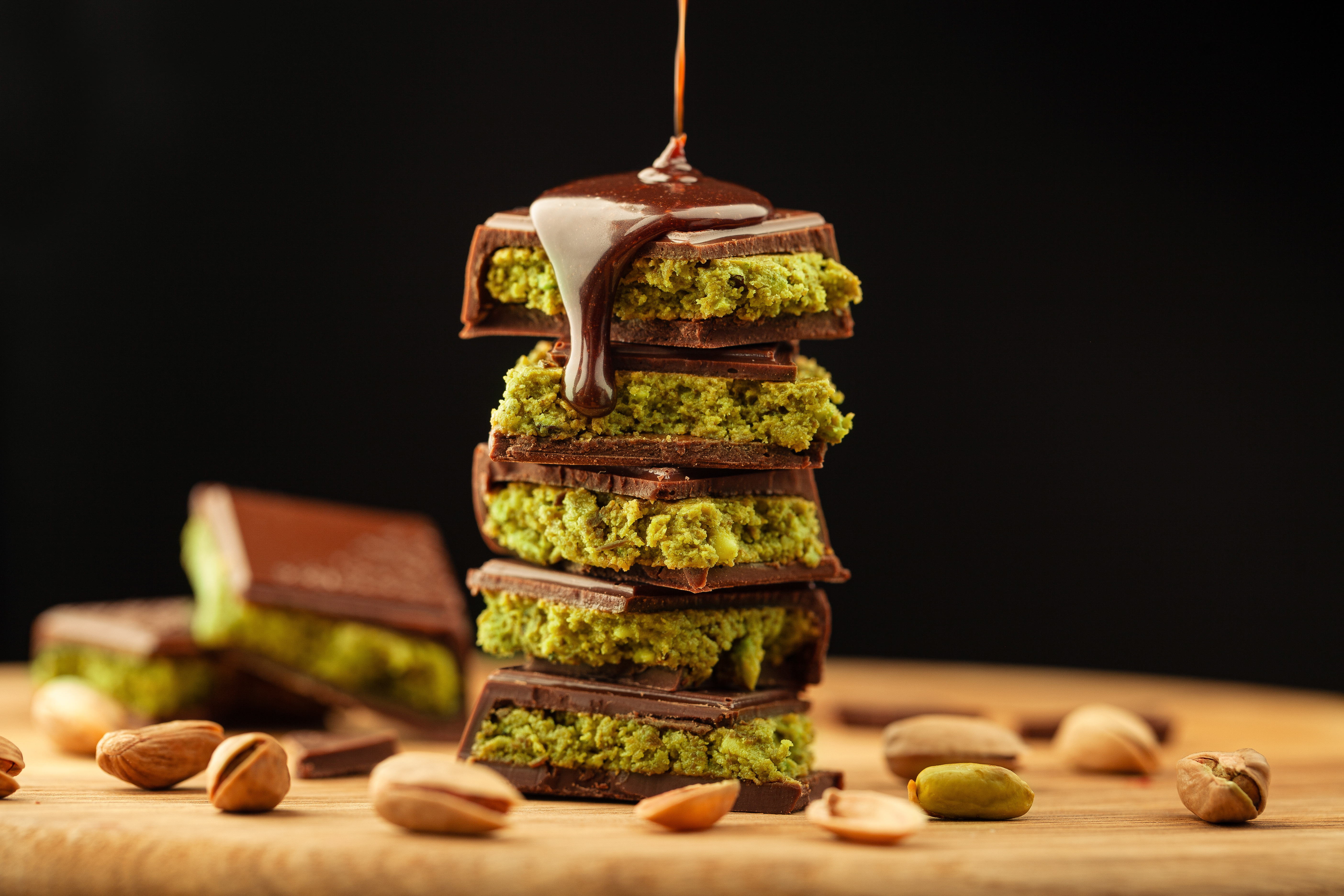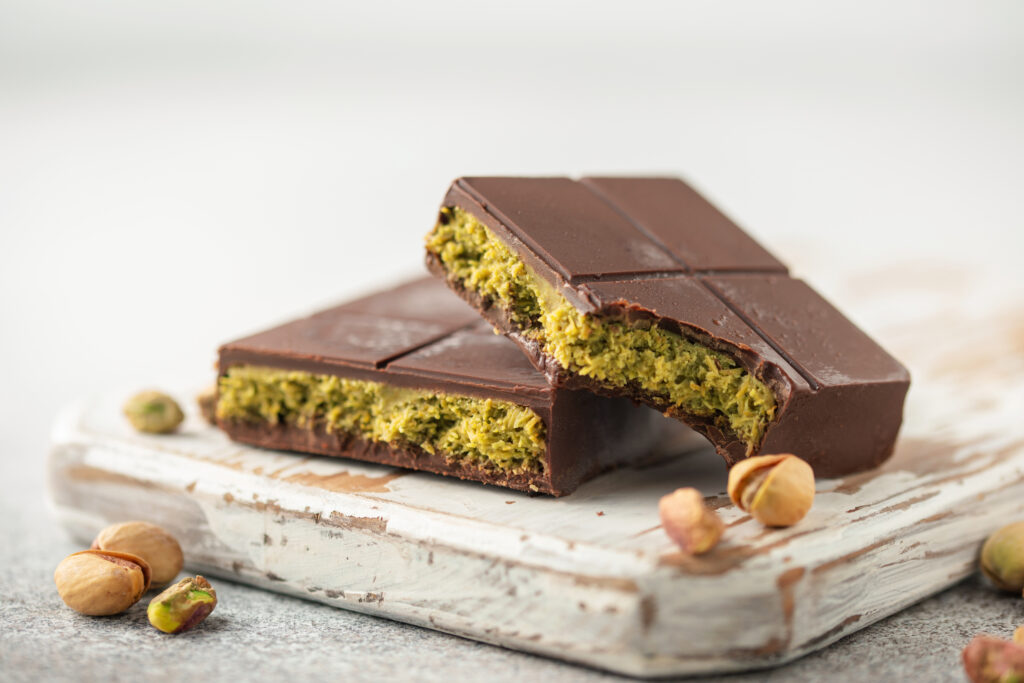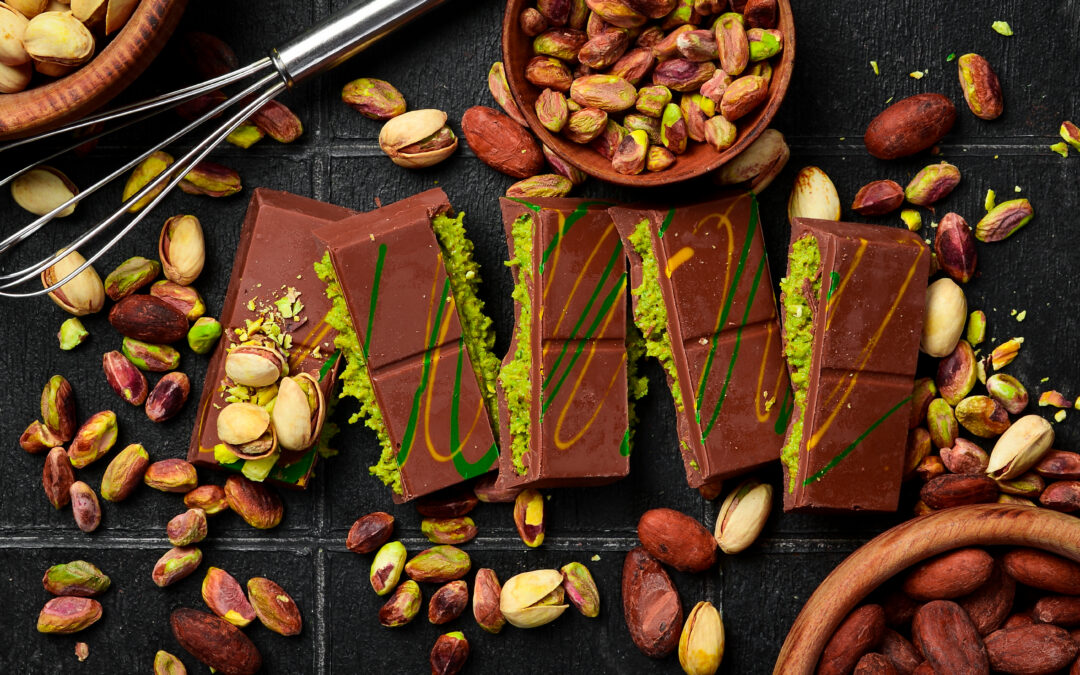A pregnant entrepreneur in Dubai had a craving. Sarah Hamouda wanted knafeh: a traditional Middle Eastern dessert of shredded phyllo pastry, cheese, and pistachios soaked in syrup. But instead of satisfying that craving conventionally, she created something entirely new.
A chunky chocolate bar filled with pistachio cream, tahini, and crispy kataifi pastry. She called it “Can’t Get Knafeh of It” and sold it from her boutique chocolatier, Fix Dessert Chocolatier.
Then TikTok discovered it.
120 Million Views Changes Everything
A single video garnered over 120 million views, showing people cracking open that distinctive bar to reveal gooey green pistachio filling studded with crunchy golden pastry. The sound was ASMR gold. The visuals were Instagram catering.
Within weeks, Dubai chocolate became the internet’s newest obsession. And the global pistachio market would never be the same.
The Numbers Tell the Story
The economic impact of a viral food trend, quantified:
Supply crash: U.S. pistachio supplies fell 20 percent from February 2024 to February 2025.
Price surge: Pistachio prices jumped 34 percent, from around eight dollars per pound to over ten dollars.
Export boom: Iran, the world’s second-largest pistachio producer, increased exports to the UAE by 40 percent in just six months to meet chocolate demand.
Market disruption: Retailers began rationing stock. The Iranian nut producer Keinia attributed the shortage directly to “the explosive surge in demand fueled by the viral Dubai chocolate TikTok trend.”
This wasn’t just a trending hashtag, it was a full-blown commodity crisis sparked by social media.

Everyone Wants In
Major brands scrambled to create their own versions, flooding the market with knockoffs of varying quality.
Lindt released a Dubai chocolate bar with almond brittle and pistachio notes. Trader Joe’s launched a pistachio-studded bar for four dollars that sold out almost instantly. Crumbl Cookies introduced Dubai-themed brownies and cheesecakes with crackable chocolate shells. Costco started stocking frozen Dubai chocolate ice cream bars. Shake Shack got in on the action with a Chocolate Pistachio Dubai Shake at select coastal locations.
U.S. retail sales of pistachio-filled chocolates totaled $822,900 in the 52 weeks ending June 28, 2025. That might sound modest compared to the $16.27 billion total chocolate market, but here’s the kicker: unit sales of pistachio-filled chocolates were up 1,234 percent compared to the previous year. Meanwhile, overall chocolate sales barely budged.
Stew Leonard Jr., CEO of Stew Leonard’s grocery stores in New York, told reporters: “I’ve never seen a single item sell like this in my 50 years of retailing.”
The Beautiful Irony
Here’s what makes this whole phenomenon delicious: the original Fix chocolate bar remains nearly impossible to obtain.
Hamouda’s operation in Dubai only sells bars for two hours a day, in limited batches, and refuses to expand internationally. The chocolate is made by hand, with each bar hand-painted with edible gold and green splatters. It’s not available for shipping. You can’t order it online unless you’re physically in the UAE.
The scarcity has only intensified the mystique. People are paying premium prices for knockoffs, many of which don’t quite capture the magic of the original—that perfect balance of creamy pistachio, nutty tahini, crunchy pastry, and smooth chocolate.
Beyond the Bar
The trend has evolved into a full category unto itself.
Bakeries are making Dubai chocolate croissants. Cafes offer Dubai chocolate lattes. During Mid-Autumn Festival, luxury hotels in Hong Kong created Dubai chocolate mooncakes, blending the viral sensation with thousand-year-old tradition.
Google searches for “Dubai chocolate” peaked in March 2025 and have remained elevated ever since. Major food conferences now feature panels on the “Dubai chocolate effect”—how a single viral product can disrupt entire agricultural supply chains and create new product categories overnight.
The Psychology of Viral Food
Why did this particular chocolate bar capture global imagination while countless other innovative desserts come and go?
It’s photogenic: That bright green filling pops on camera like nothing else. Every crack of the chocolate shell reveals that Instagrammable contrast.
It’s exotic without being alienating: Pistachios feel luxurious but familiar. Most people have tried pistachio ice cream or baklava. This isn’t so foreign that it’s intimidating.
It delivers on texture: Crunchy and creamy simultaneously—a sensory experience that translates beautifully to ASMR videos. You can almost feel and hear it through the screen.
It carries a story: Pregnant entrepreneur, Middle Eastern tradition meets modern innovation, handcrafted scarcity. There’s narrative depth beyond “new chocolate flavor.”
Scarcity creates desire: The fact that you can’t easily get the original makes it even more desirable. FOMO is a powerful marketing force.

What It Says About Food Culture Now
Dubai chocolate represents something bigger than one viral dessert. It’s a case study in how food trends work in 2025.
Social media has compressed trend cycles. What used to take years to spread globally now happens in weeks. A single TikTok video can create international demand overnight.
Authenticity matters less than accessibility. Most people eating “Dubai chocolate” aren’t getting the original. They’re getting versions from Trader Joe’s or their local bakery. And that’s okay—the concept is what went viral, not just the specific product.
Food has become content. We’re not just eating desserts; we’re experiencing them, filming them, sharing them. The consumption is both physical and digital.
Niche can become mainstream instantly. A boutique chocolatier in Dubai making small batches can spark a global phenomenon without ever scaling production. The trend scales even if the original product doesn’t.
Why We Love It
There’s something delightfully absurd about a chocolate bar causing an international agricultural shortage, but it speaks to our current cultural moment perfectly.
We’re living in an era where a single TikTok video can reshape global supply chains overnight. Where food trends spread faster than epidemics. Where scarcity becomes its own marketing strategy, and FOMO drives purchasing decisions as much as taste.
But beneath the chaos and economics, there’s something genuinely joyful about Dubai chocolate’s rise. It’s a reminder that innovation can come from anywhere—a pregnant woman’s craving, a small boutique, a cultural tradition reimagined. It’s proof that in our hyperconnected world, a great idea and a killer product can quite literally change markets overnight.
For those of us who can’t get our hands on the original, the proliferation of alternatives means we can at least taste the phenomenon. We can participate in the cultural moment even if we’re thousands of miles from Dubai.
And for Sarah Hamouda, who started with a pregnancy craving and created a global sensation? She’s living proof that sometimes the best business ideas come from simply making something you wish existed—and making it so good that the world takes notice.

